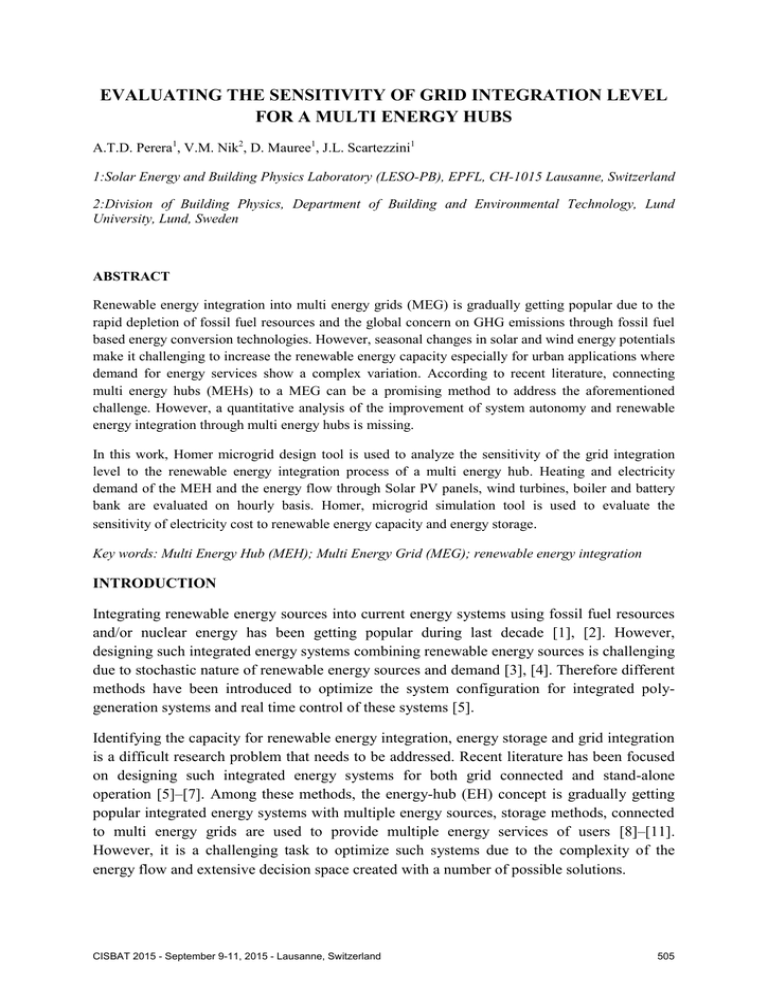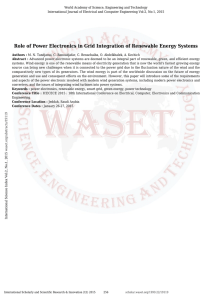EVALUATING THE SENSITIVITY OF GRID INTEGRATION LEVEL
advertisement

EVALUATING THE SENSITIVITY OF GRID INTEGRATION LEVEL FOR A MULTI ENERGY HUBS A.T.D. Perera1, V.M. Nik2, D. Mauree1, J.L. Scartezzini1 1:Solar Energy and Building Physics Laboratory (LESO-PB), EPFL, CH-1015 Lausanne, Switzerland 2:Division of Building Physics, Department of Building and Environmental Technology, Lund University, Lund, Sweden ABSTRACT Renewable energy integration into multi energy grids (MEG) is gradually getting popular due to the rapid depletion of fossil fuel resources and the global concern on GHG emissions through fossil fuel based energy conversion technologies. However, seasonal changes in solar and wind energy potentials make it challenging to increase the renewable energy capacity especially for urban applications where demand for energy services show a complex variation. According to recent literature, connecting multi energy hubs (MEHs) to a MEG can be a promising method to address the aforementioned challenge. However, a quantitative analysis of the improvement of system autonomy and renewable energy integration through multi energy hubs is missing. In this work, Homer microgrid design tool is used to analyze the sensitivity of the grid integration level to the renewable energy integration process of a multi energy hub. Heating and electricity demand of the MEH and the energy flow through Solar PV panels, wind turbines, boiler and battery bank are evaluated on hourly basis. Homer, microgrid simulation tool is used to evaluate the sensitivity of electricity cost to renewable energy capacity and energy storage. Key words: Multi Energy Hub (MEH); Multi Energy Grid (MEG); renewable energy integration INTRODUCTION Integrating renewable energy sources into current energy systems using fossil fuel resources and/or nuclear energy has been getting popular during last decade [1], [2]. However, designing such integrated energy systems combining renewable energy sources is challenging due to stochastic nature of renewable energy sources and demand [3], [4]. Therefore different methods have been introduced to optimize the system configuration for integrated polygeneration systems and real time control of these systems [5]. Identifying the capacity for renewable energy integration, energy storage and grid integration is a difficult research problem that needs to be addressed. Recent literature has been focused on designing such integrated energy systems for both grid connected and stand-alone operation [5]–[7]. Among these methods, the energy-hub (EH) concept is gradually getting popular integrated energy systems with multiple energy sources, storage methods, connected to multi energy grids are used to provide multiple energy services of users [8]–[11]. However, it is a challenging task to optimize such systems due to the complexity of the energy flow and extensive decision space created with a number of possible solutions. CISBAT 2015 - September 9-11, 2015 - Lausanne, Switzerland 505 Recently, number of groups has focused on implementing the energy hub concept at neighbourhood level where integration of non-dispatchable energy sources such as SPV and wind energy is given a priority. However, the limits for the integration of these energy sources and the requirement of energy storage in this process need to be analysed. This extends the design problem of these energy hubs from classical cost optimization. OVERVIEW OF THE CONSIDERED ENERGY SYSTEMS Energy storage and dispatchable energy sources are connected to renewable energy sources in order to absorb the fluctuations in renewable energy potential. This creates a complicated energy flow within the system with multiple options to be selected such as battery banks, H2fuel cells and compressed air storage which can be used to absorb the fluctuations of renewable energy. In addition, dispatchable energy sources are used to generate electricity whenever renewable energy potential is not sufficient enough to provide the demand. In this study, an internal combustion generator, SPV panels and wind turbines are used to generate electricity. A battery bank is used as electricity storage. In addition, the hub is connected to the main grid in order to provide mismatch in demand. The electrical part consists of an AC bus and a DC bus. An internal Combustion Generator (ICG) and wind turbines are connected to the AC bus while SPV panels and a battery bank are connected to the DC bus. In this work only an AC load is considered. However, this can be extended considering a DC load such as vehicle charging as well. In addition, the thermal load is catered using a boiler. Interactions with a thermal grid in order to meet the thermal demand are not considered in this work. AC Bus DC Bus ICG Electric Load Solar PV Panels Grid Converter Battery Bank Wind Turbines Thermal Load Controller Thermal Bus Thermal Load Boiler Figure 1 Overview of the energy hub 506 CISBAT 2015 - September 9-11, 2015 - Lausanne, Switzerland METHODOLOGY Hourly solar irradiation and wind speed data need to be collected in order to determine the solar and wind energy potential. Subsequently, the energy conversion efficiency of SPV modules and wind turbines is calculated which helps to determine the power generation of non-dispatchable renewable energy sources. After determining the power generation from non-dispatchable energy sources, the operating state of the battery bank and ICG is determined using the dispatch strategy. This routine is used to simulate the system throughout the year considering a time step of one hour for 8760 time steps. The electrical and thermal demands for the application are taken according to Figure 2. Based on the simulation, the energy flow through system components is analysed for different COE in grid scenarios. Figure 2 Thermal and electrical demand of the hub The energy flow model used for this study is based on Homer micro grid simulation software. Monthly average global horizontal data, wind speed and ambient temperatures are taken from the NASA surface meteorology and solar energy data base. The power curve for the wind turbine is taken based on commercially available wind turbine (Figure 3). SPV panels are modelled considering an operating temperature to be 47 °C and temperature coefficient of 0.5. The cycle counting method is used to calculate the lifetime of the battery bank. The cycle charging strategy is used as the dispatch strategy [12]–[14]. Subsequently, hub is optimized considering life cycle cost as the objective function. A direct search method is used by Homer in optimizing energy hubs. All the possible combinations for system design are evaluated based on the objective function. For this case study, 4968 solutions are simulated and compared in the optimization algorithm. CISBAT 2015 - September 9-11, 2015 - Lausanne, Switzerland 507 Figure 3 Power curve of the wind turbine RESULTS AND DISCUSSION Four different scenarios are taken into discussion in this work. Three scenarios are taken considering the grid connected operation mode. Finally, fourth considers the standalone operation mode which is taken as the reference case. The three grid connected cases are named Case A, Case B and Case C according to the ascending order of the grid price. Case D is based on the standalone application. Results of the optimized systems are illustrated in Table 1. Table 1: Results of the case studies Case Renewable energy percentage (%) SPV capacity (kW) SPV contribution (%) Wind turbine capacity (kW) Wind turbine contribution (%) Case A 60 10 55 3 5 Case B 65 12 60 3 5 Case C 72 16 68 3 4 Case D 63 14 67 6 23 Battery banks 0 0 0 23 Throughput of battery (kWh/year) Fuel consumption of ICG (l/yr) 0 0 0 0 0 0 2161 1949 Units purchased from grid (kWh) 8717 8346 7821 0 Units sent to grid (KWh) 4485 6295 10130 0 The renewable energy level gradually increases when moving from Case A to Case C. This demonstrates that higher cost of the electricity grid encourages higher integration of renewable energy. SPV and wind energy generation increase from 60% to 72% with the increase of grid electricity prices. However, ICG and battery banks are not found in optimized design solutions for grid integrated designs. This clearly emphasizes that the grid has the capability to absorb the fluctuations of renewable energy without any support from dispatchable energy sources or storage. However, the battery bank size is 23 kWh for a standalone system which includes an ICG in addition to the battery bank. When considering the ICG for Case D, it operates during night at full load where SPV generation is not significant. At the same time the battery bank is charging during the daytime 508 CISBAT 2015 - September 9-11, 2015 - Lausanne, Switzerland and gets discharged during the night when the solar energy potential is not significant. The boiler is used to provide the heat demand of the application. Since the thermal grid or storage is not connected to the system, a significant change is not observed for the thermal part of the hub. When analysing the standalone application it is clear that both ICG and battery bank are used to meet the demand quite often. Figure 4 clearly demonstrates that ICG is operated at full load throughout the year except for the daytime where SPV generates electricity. Similarly, the battery bank is charged during the daytime and is getting discharged during the night (Figure 5). This clearly demonstrates that both dispatchable energy source and storage play an important role in standalone applications which is performed by grid for grid connected applications. Load Factor of ICG 100 % 0% Figure 4 Operating conditions of ICG for Case D Figure 5 Operating conditions of the battery bank for Case D CISBAT 2015 - September 9-11, 2015 - Lausanne, Switzerland 509 CONCLUSIONS This study focuses on integrating renewable energy sources through energy hubs to provide multiple energy services. The results obtained through the study shows that a higher level of non dispatchable renewable energy capacity can be handled with the support of the grid. However, it was demonstrated that both energy storage and a dispatchable energy source are required to achieve a 100% autonomy level. References [1] [2] [3] [4] [5] [6] [7] [8] [9] [10] [11] [12] [13] [14] 510 B. Ćosić, G. Krajačić, and N. Duić, “A 100% renewable energy system in the year 2050: The case of Macedonia,” Energy, vol. 48, no. 1, pp. 80–87, Dec. 2012. G. Krajačić, N. Duić, Z. Zmijarević, B. V. Mathiesen, A. A. Vučinić, and M. da Graça Carvalho, “Planning for a 100% independent energy system based on smart energy storage for integration of renewables and CO2 emissions reduction,” Appl. Therm. Eng., vol. 31, no. 13, pp. 2073–2083, Sep. 2011. A. T. D. Perera, R. A. Attalage, K. K. C. K. Perera, and V. P. C. Dassanayake, “Converting existing Internal Combustion Generator (ICG) systems into HESs in standalone applications,” Energy Convers. Manag., vol. 74, pp. 237–248, Oct. 2013. A. T. D. Perera, R. A. Attalage, K. K. C. K. Perera, and V. P. C. Dassanayake, “Designing standalone hybrid energy systems minimizing initial investment, life cycle cost and pollutant emission,” Energy, vol. 54, pp. 220–230, Jun. 2013. A. H. Fathima and K. Palanisamy, “Optimization in microgrids with hybrid energy systems – A review,” Renew. Sustain. Energy Rev., vol. 45, pp. 431–446, May 2015. S. Upadhyay and M. P. Sharma, “A review on configurations, control and sizing methodologies of hybrid energy systems,” Renew. Sustain. Energy Rev., vol. 38, pp. 47–63, Oct. 2014. D. Neves, C. A. Silva, and S. Connors, “Design and implementation of hybrid renewable energy systems on micro-communities: A review on case studies,” Renew. Sustain. Energy Rev., vol. 31, pp. 935–946, Mar. 2014. M. Geidl and G. Andersson, “Optimal Power Flow of Multiple Energy Carriers,” IEEE Trans. Power Syst., vol. 22, no. 1, pp. 145–155, Feb. 2007. R. Evins, K. Orehounig, V. Dorer, and J. Carmeliet, “New formulations of the ‘energy hub’ model to address operational constraints,” Energy, vol. 73, pp. 387–398, Aug. 2014. K. Orehounig, R. Evins, and V. Dorer, “Integration of decentralized energy systems in neighbourhoods using the energy hub approach,” Appl. Energy, vol. 154, pp. 277–289, Sep. 2015. F. Brahman, M. Honarmand, and S. Jadid, “Optimal electrical and thermal energy management of a residential energy hub, integrating demand response and energy storage system,” Energy Build., vol. 90, pp. 65–75, Mar. 2015. A. T. D. Perera, D. M. I. J. Wickremasinghe, D. V. S. Mahindarathna, R. A. Attalage, K. K. C. K. Perera, and E. M. Bartholameuz, “Sensitivity of internal combustion generator capacity in standalone hybrid energy systems,” Energy, vol. 39, no. 1, pp. 403–411, Mar. 2012. A. T. D. Perera, R. A. Attalage, K. K. C. K. Perera, and V. P. C. Dassanayake, “A hybrid tool to combine multi-objective optimization and multi-criterion decision making in designing standalone hybrid energy systems,” Appl. Energy, vol. 107, pp. 412–425, Jul. 2013. A. T. D. Perera, D. M. I. J. Wickremasinghe, D. V. S. Mahindarathna, R. A. Attalage, K. K. C. K. Perera, and E. M. Bartholameuz, “Determining wind turbine capacity for expansion of off grid Internal Combustion Generators (ICG) system; why it bec o mes challenging?,” in 2010 IEEE International Conference on Sustainable Energy Technologies (ICSET), 2010, pp. 1–5. CISBAT 2015 - September 9-11, 2015 - Lausanne, Switzerland


